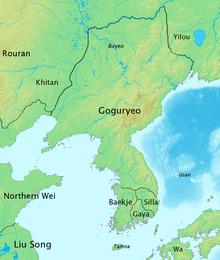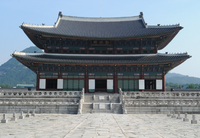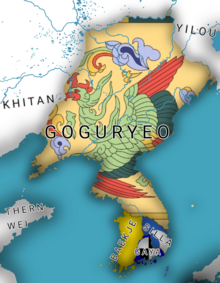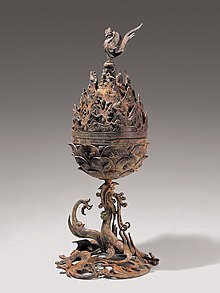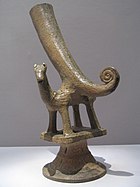
The Lower Paleolithic era on the Korean Peninsula and in Manchuria began roughly half a million years ago. The earliest known Korean pottery dates to around 8000 BC, and the Neolithic period began after 6000 BC, followed by the Bronze Age by 2000 BC, and the Iron Age around 700 BC. Similarly, according to The History of Korea, the Paleolithic people are not the direct ancestors of the present Korean people, but their direct ancestors are estimated to be the Neolithic People of about 2000 BC.

Goguryeo also later known as Goryeo, was a Korean kingdom which was located on the northern and central parts of the Korean Peninsula and the southern and central parts of modern-day Northeast China (Manchuria). At its peak of power, Goguryeo conquered most of the Korean Peninsula and large parts of Manchuria, along with parts of eastern Mongolia, Inner Mongolia, and modern-day Russia.
There are various names of Korea in use today that are all derived from those of ancient Koreanic kingdoms and dynasties. The choice of name often depends on the language, whether the user is referring to either or both modern Korean countries, and even the user's political views on the Korean conflict.

Baekje or Paekche was a Korean kingdom located in southwestern Korea from 18 BC to 660 AD. It was one of the Three Kingdoms of Korea, together with Goguryeo and Silla. While the three kingdoms were in separate existence, Baekje had the highest population of approximately 3,800,000 people, which was much larger than that of Silla and similar to that of Goguryeo.
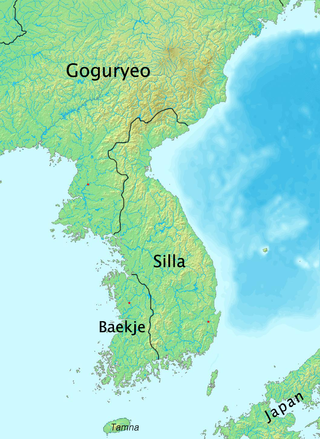
Silla, was a Korean kingdom that existed between 57 BCE – 935 CE and located on the southern and central parts of the Korean Peninsula. Silla, along with Baekje and Goguryeo, formed the Three Kingdoms of Korea. Silla had the lowest population of approximately 850,000 people, which was significantly smaller than those of Baekje and Goguryeo.

Gojoseon, also called Joseon, was the first kingdom on the Korean Peninsula. According to Korean mythology, the kingdom was established by the legendary king Dangun. Gojoseon possessed the most advanced culture in the Korean Peninsula at the time and was an important marker in the progression towards the more centralized states of later periods. The addition of Go, meaning "ancient", is used in historiography to distinguish the kingdom from the Joseon dynasty, founded in 1392 CE.

Buyeo, also rendered as Puyŏ or Fuyu, was an ancient kingdom that was centered in northern Manchuria in modern-day northeast China. It had ties to the Yemaek people, who are considered to be the ancestors of modern Koreans. Buyeo is considered a major predecessor of the Korean kingdoms of Goguryeo and Baekje.
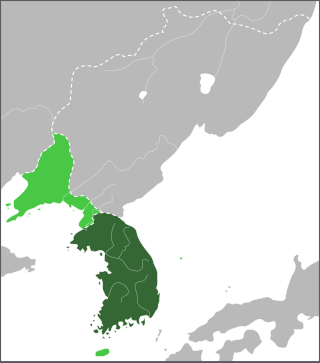
Unified Silla, or Late Silla, is the name often applied to the Korean kingdom of Silla, one of the Three Kingdoms of Korea, after 668 CE. In the 7th century, a Silla–Tang alliance conquered Baekje in the Baekje–Tang War. Following the Goguryeo–Tang War and Silla–Tang War in the 7th century, Silla conquered the southern part of Goguryeo, unifying the central and southern regions of the Korean peninsula.

Seong of Baekje was the 26th king of Baekje, one of the Three Kingdoms of Korea. He was a son of Muryeong of Baekje and is best known for making Buddhism the state religion, moving the national capital to Sabi, and reclaiming the center of the Korean Peninsula. His demise eventually came at the hands of an ally who betrayed him. The name Seong translates as 'The Holy.'

Gaya was a Korean confederacy of territorial polities in the Nakdong River basin of southern Korea, growing out of the Byeonhan confederacy of the Samhan period.

Geumgwan Gaya (43–532), also known as Bon-Gaya or Garakguk, was the ruling city-state of the Gaya confederacy during the Three Kingdoms period in Korea. It is believed to have been located around the modern-day city of Gimhae, Southern Gyeongsang province, near the mouth of the Nakdong River. Due to its geographic location, this kingdom played a dominant role in the regional affairs from the Byeonhan period onward to the end of the Gaya confederacy.

King Mu of Baekje (581?–641) was the 30th king of Baekje, one of the Three Kingdoms of Korea. He was the 4th son of King Baekje.
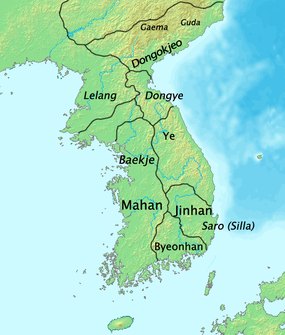
Jinhan was a loose confederacy of chiefdoms that existed from around the 1st century BC to the 4th century AD in the southern Korean Peninsula, to the east of the Nakdong River valley, Gyeongsang Province. Jinhan was one of the Samhan, along with Byeonhan and Mahan. Apparently descending from the Jin state of southern Korea, Jinhan was absorbed by the later Silla, one of the Three Kingdoms of Korea.

Samhan, or Three Han, is the collective name of the Byeonhan, Jinhan, and Mahan confederacies that emerged in the first century BC during the Proto–Three Kingdoms of Korea, or Samhan, period. Located in the central and southern regions of the Korean Peninsula, the Samhan confederacies eventually merged and developed into the Baekje, Gaya, and Silla kingdoms. The name "Samhan" also refers to the Three Kingdoms of Korea.

Korea's military history spans thousands of years, beginning with the ancient nation of Gojoseon and continuing into the present day with the countries of North Korea and South Korea, and is notable for its many successful triumphs over invaders.

The Proto–Three Kingdoms period refers to the proto-historical period in the Korean Peninsula, after the fall of Gojoseon and before the maturation of Goguryeo, Baekje, and Silla into full-fledged kingdoms. It is a subdivision of what is traditionally called Korea's Three Kingdoms period and covers the first three centuries of the Common Era, corresponding to the later phase of the Korean Iron Age.

The crowns of Silla were made in the Korean kingdom of Silla approximately in the 5th–7th centuries.
The Goguryeo controversies are disputes between China and Korea on the history of Goguryeo, an ancient kingdom located in present-day Northeast China and the Korean Peninsula. At the heart of the Goguryeo controversy is which part of history the kingdom belongs to. Korean scholars have the viewpoint that Goguryeo is part of Korean history alone.

The Han languages or Samhan languages were the languages of the Samhan of ancient southern Korea, the confederacies of Mahan, Byeonhan and Jinhan. They are mentioned in surveys of the peninsula in the 3rd century found in Chinese histories, which also contain lists of placenames, but are otherwise unattested. There is no consensus about the relationships between these languages and the languages of later kingdoms.
